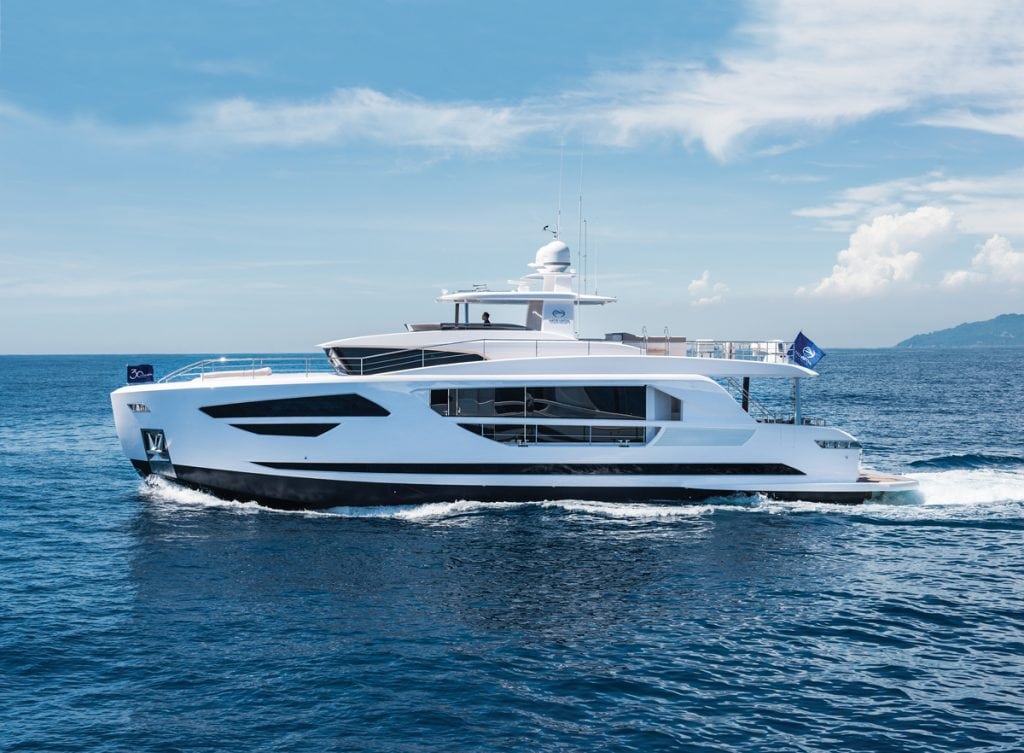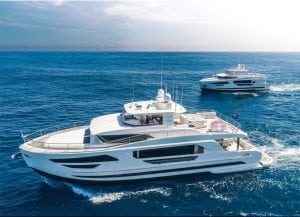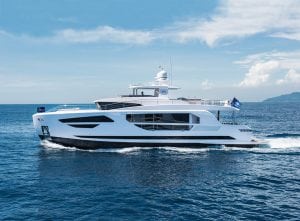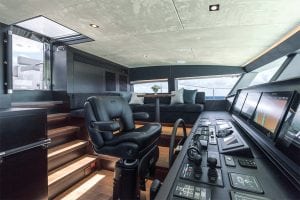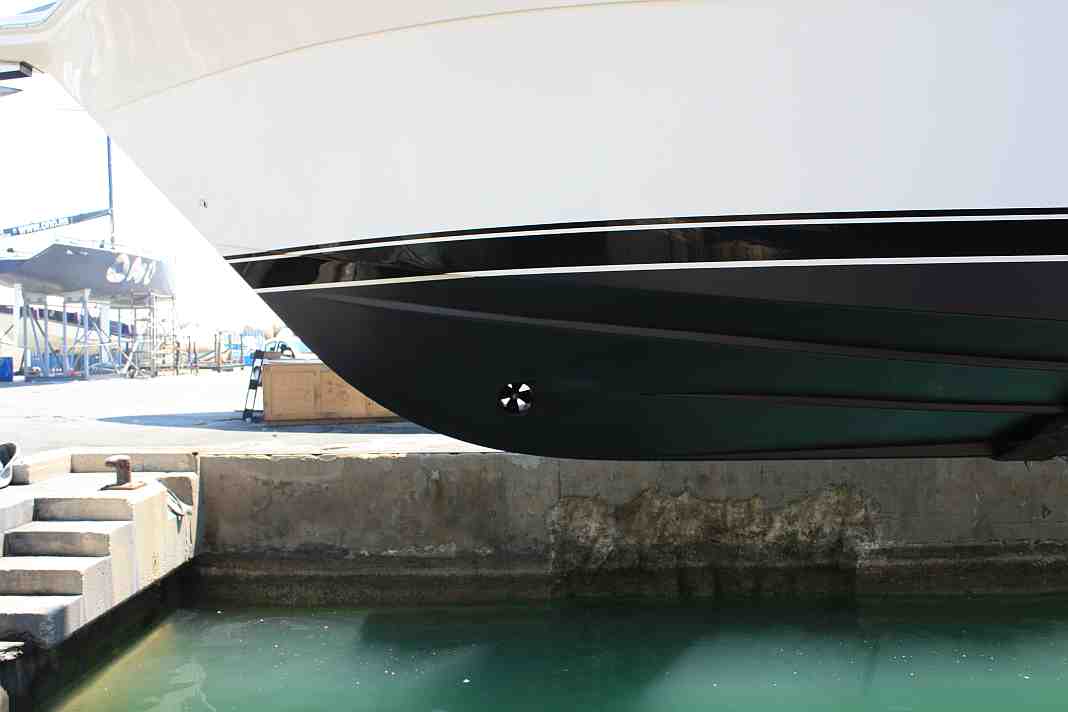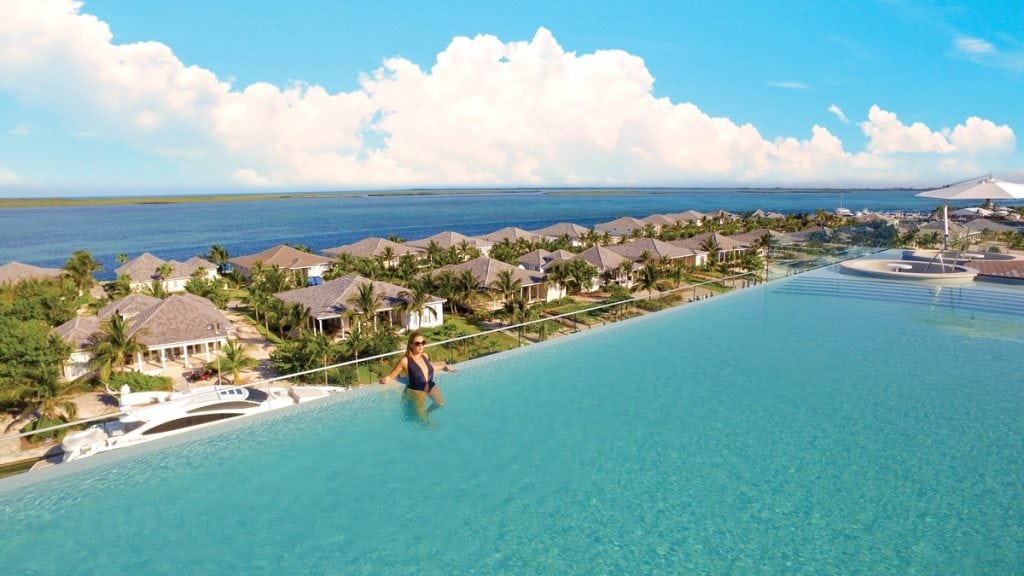Two of yachting’s powerhouses join forces to advance the luxury, performance, and comfort of cruising motoryachts with the new Horizon FD Series.
There’s an increased interest in fast displacement hull forms these days, expanding both ends of a spectrum of operating speeds and efficiency choices owners want and need in their busy lives. If you attended the Fort Lauderdale International Boat Show in 2016, you probably saw—and perhaps even toured—the new Horizon Yachts’ Fast Displacement 85, or FD85, a collaboration between the CEO of Horizon Yachts, the renowned Asian yacht builder John Lu, and Cor D. Rover, a Dutch design studio known for its creative, elegant and well-thought-out contemporary motoryacht styling. The FD85 is Horizon Yachts’ first in a line of fast displacement yachts—hull No. 2 makes its European debut this month at the 2017 Cannes Yachting Festival September 12-17—that is planned to include the FD74 and the FD102.
The FD85 is very hard to miss. Crisp styling lines allow her to stand out among a plethora of boats too similar in design to catch the eye. The 23-foot, 3-inch beam carries well forward to a plumb bow, all riding on a fast displacement hull running surface that, once explained, proves to be most interesting. Inside, beautifully functional, high-volume living and entertaining spaces are on the main deck and five ensuite staterooms on the accommodations deck, plus crew quarters. Loads of natural light illuminate all of the spaces aboard, particularly the main salon where the side windows extend nearly to the level of the outside deck.
Recently, Southern Boating interviewed Lu and Rover, the driving forces behind Horizon Yachts’ new Horizon FD (Fast Displacement) Series, to learn more about how the FD85 came to be.
Some say that a majority of today’s motoryacht owners prefer to cruise in the 12-to 15-knot range, a definite bump over the 9 knots that was considered respectable when trawlers were becoming a dominant market factor. Do you agree?
“Yes, most of the old perceptions about motor yacht cruising involved single- or twin-engine trawlers,” said Lu. “However, after listening to our clients, we understood that they wanted the economy and comfort of slower speeds but also a little ‘extra’ available on the speed side. For many of them, time on board is special, and they want to get the most out of their trips/destination.
“As an example, trips to The Bahamas from Florida’s east coast can be as short as 55 miles, and at 9 knots that is just over 6 hours; at 13 knots, it is just over 4 hours for the trip, so this means in an 8-hour day you can cover 100 miles at 13 knots, while at 9 knots you can only travel about 72 miles. That is a big difference for most owners who nowadays have limited time on board their yacht and wish to spend that time relaxing and enjoying their destination,” he adds.
“In the past, going faster always meant burning a lot of fuel, and sometimes when the sea state was rough, easily damaging things like glassware in the galley, not to mention
the harmony between friends and family,” said Rover. “With today’s hull designs, a few extra knots of speed do not come at a high cost. Hulls have been optimized overall for better fuel economy, and bow designs have been improved to avoid slamming. The collaboration between the team of in-house naval architects at Horizon Yachts, the added expertise of the naval architects at Donald Blount & Associates, and our European design
office has produced the leading-edge performance and contemporary styling that characterizes the FD series, giving our clients the best of both worlds.”
It is interesting to note that Rover, while best-known for his design work, also has a background that includes mechanical engineering as well as naval architecture. “My aesthetic creativity, which now makes up 99 percent of our studio’s work, is a God-given talent that I discovered and matured over time. Nevertheless, as soon as you start
sketching, styling and sculpting any new yacht, big or small, it’s good to know how things work and why yachts stay afloat.
“For the whole Horizon FD Series, the quality of life on board is paramount. All the experience and client feedback that I collected over the years has been used in these designs, which encompass American and Australian standards of convenience and living space—something that is often underestimated in some European designs.
“As an example, the owners will sleep in a full-beam stateroom on the main-deck level, or just a few steps down. This concept, which is in the mainstream of our megayacht
designs allow stunning sea views and maximum privacy.”
Horizon Yachts has long been a leader in owner-influenced, semi-custom luxury yacht offerings. To what degree do owners have the ability to change the layouts of the new Horizon FD Series yachts?
“Our company is known for listening to our clients, and the Horizon FD series is a perfect example,” said Lu. “The FD85 was first introduced to the public at FLIBS in 2016 as an open-bridge, raised pilothouse model, and she garnered a lot of attention for her unique design, interior volume and flexible performance. Two clients at the show were keenly interested in the FD85 but had some specific requirements that weren’t featured in the model, so the Horizon team went to the drawing boards and developed the FD87 Skyline, which is an enclosed bridge with a stern beach club design, in response to those needs.
“Going beyond that, we added the FD87 as an official model to the FD series lineup because we felt she appealed to a different part of the client base looking for the enclosed bridge and/or beach club features. This all happened within a seven-week time frame, and we will be delivering the first FD87 Skyline model to her new U.S. owner in December of this year. On this same note of owner influence, we have also just drawn a cockpit motoryacht version of the FD series that will appeal to the crossover fishing and sport diving families that want the motoryacht comfort as well as the ability to catch their own dinner.”
Were new processes developed to increase performance/range, thus further cementing Horizon’s reputation for highest-quality yacht production?
“Our goal is always to enhance the safety and performance of the boat, which includes researching carbon fiber and how we can implement this into our yachts,” Lu said. “Atech Composites—Horizon’s own composites manufacturer—has years of experience designing and fabricating carbon fiber components for unmanned aircraft for Taiwan’s government. This material technology and processes has provided us with invaluable knowledge of carbon fiber and how we can relate it to yachts.
“We began applying carbon fiber to some of our custom yacht components several years ago, constructing large-scale units such as radar arches, hardtops and enclosed bridges. This was of great benefit, as carbon fiber has proven to help reduce weight and improve upon the strength of these components. We have increased our focus on utilizing carbon fiber and recently developed smaller components, such as pantograph doors for the pilothouse and tender garages, for the Horizon FD and E series; these components are lighter weight and thus easier for owners to use. Carbon fiber is something we will continue to pursue for the overall safety, comfort and functionality of our yachts for our owners.”
Before the end of the year, expect to hear more about the FD85 Skyline, as well as the FD74 and the FD102. When you merge the design, engineering, and craftsmanship of Horizon Yachts with the insightful and breathtaking styling of Cor D. Rover Design, the
results speak for themselves.
By John Wooldridge Southern Boating,
September 2017

